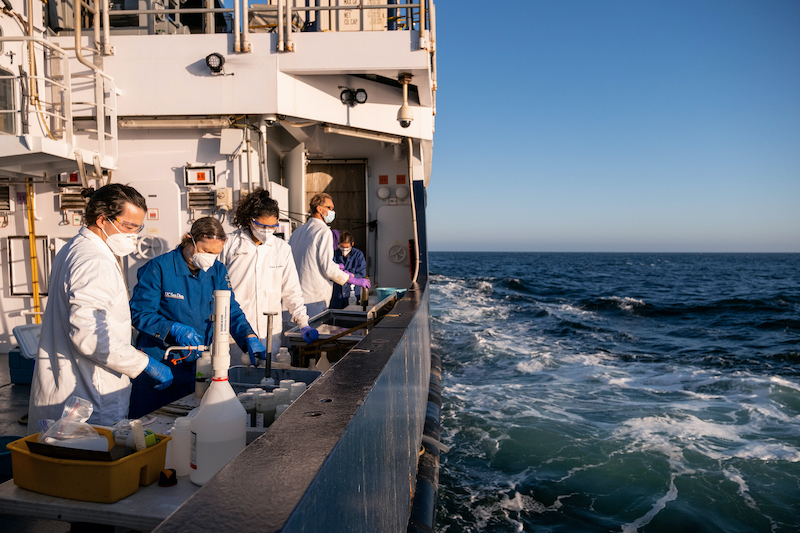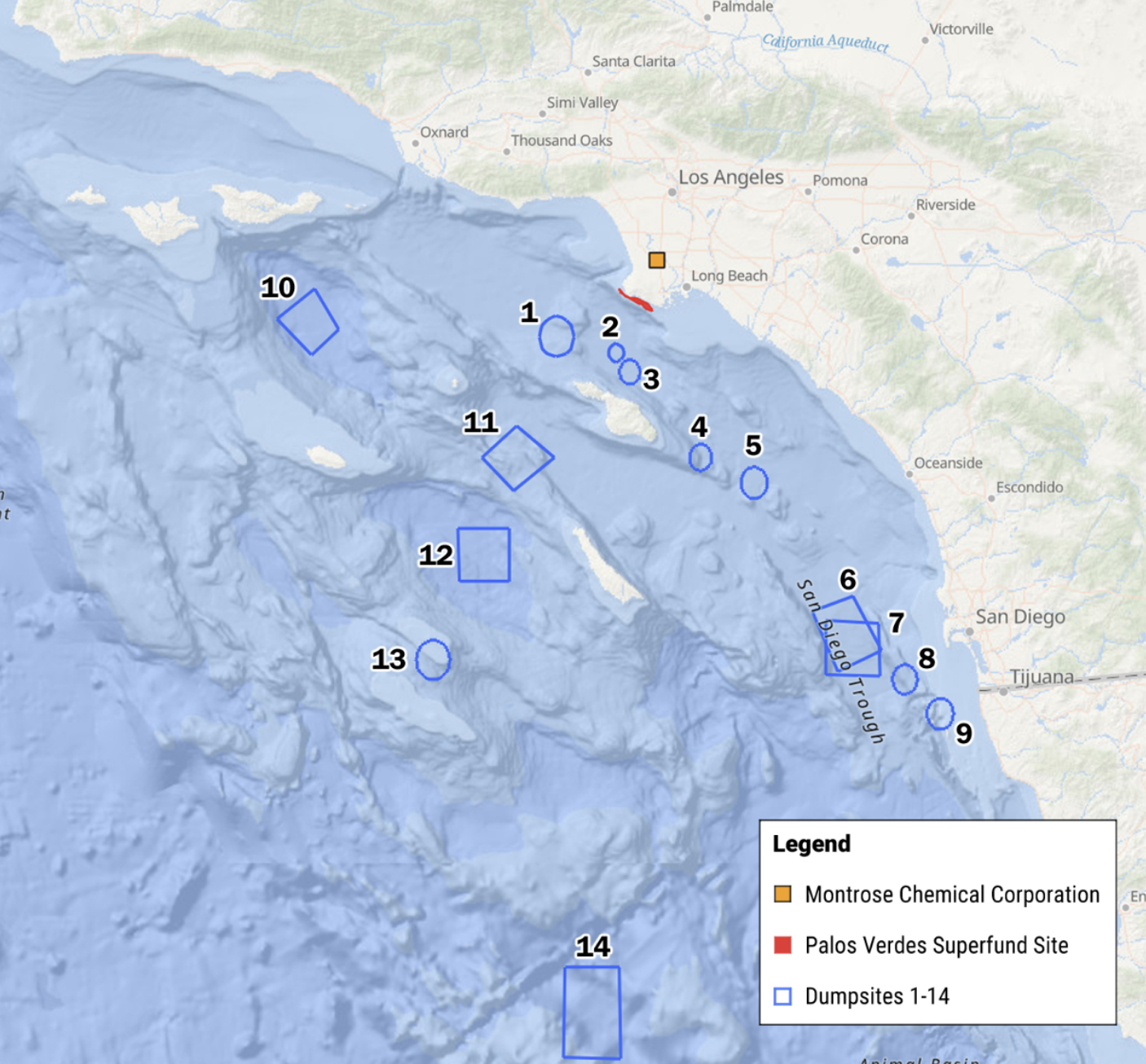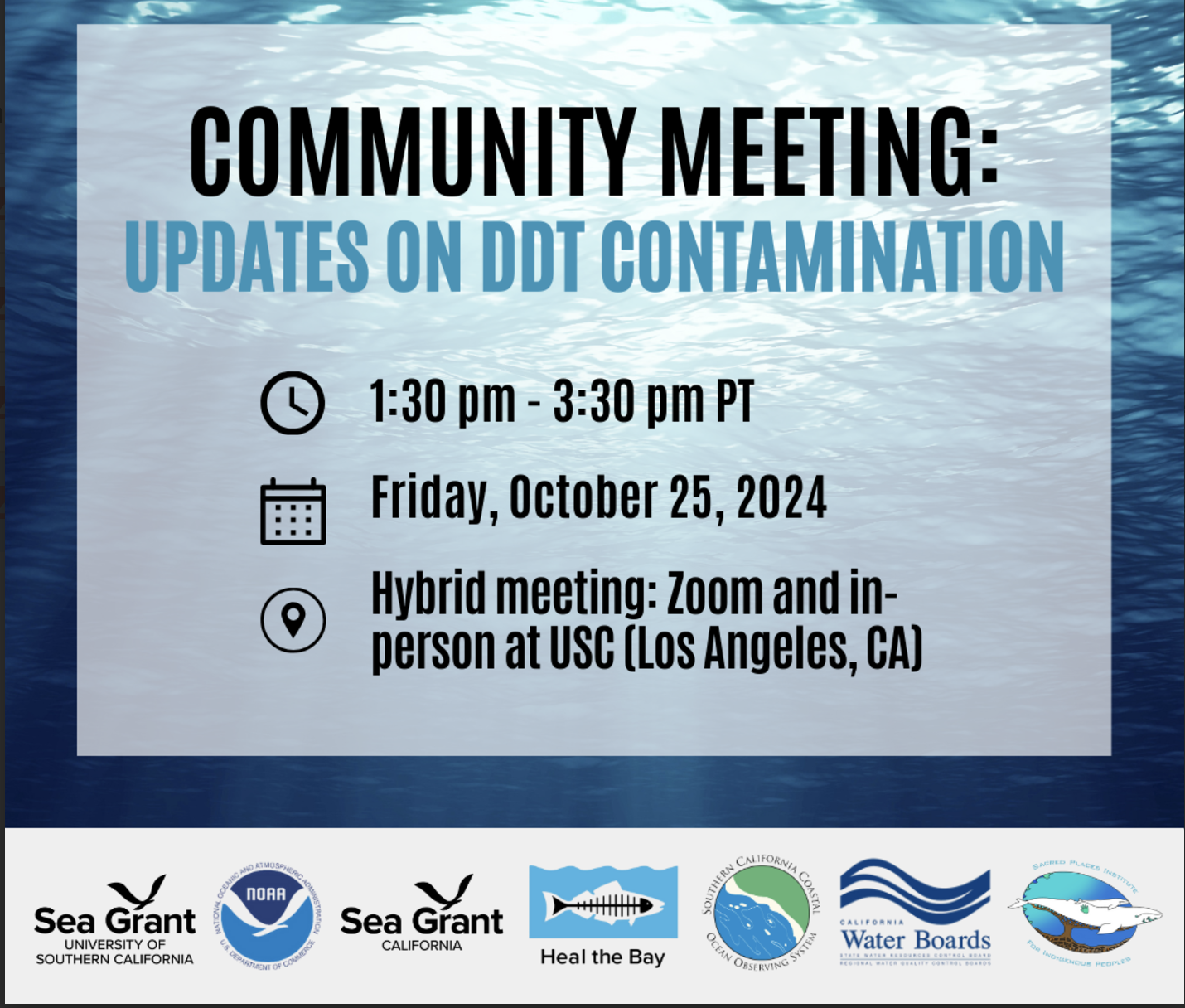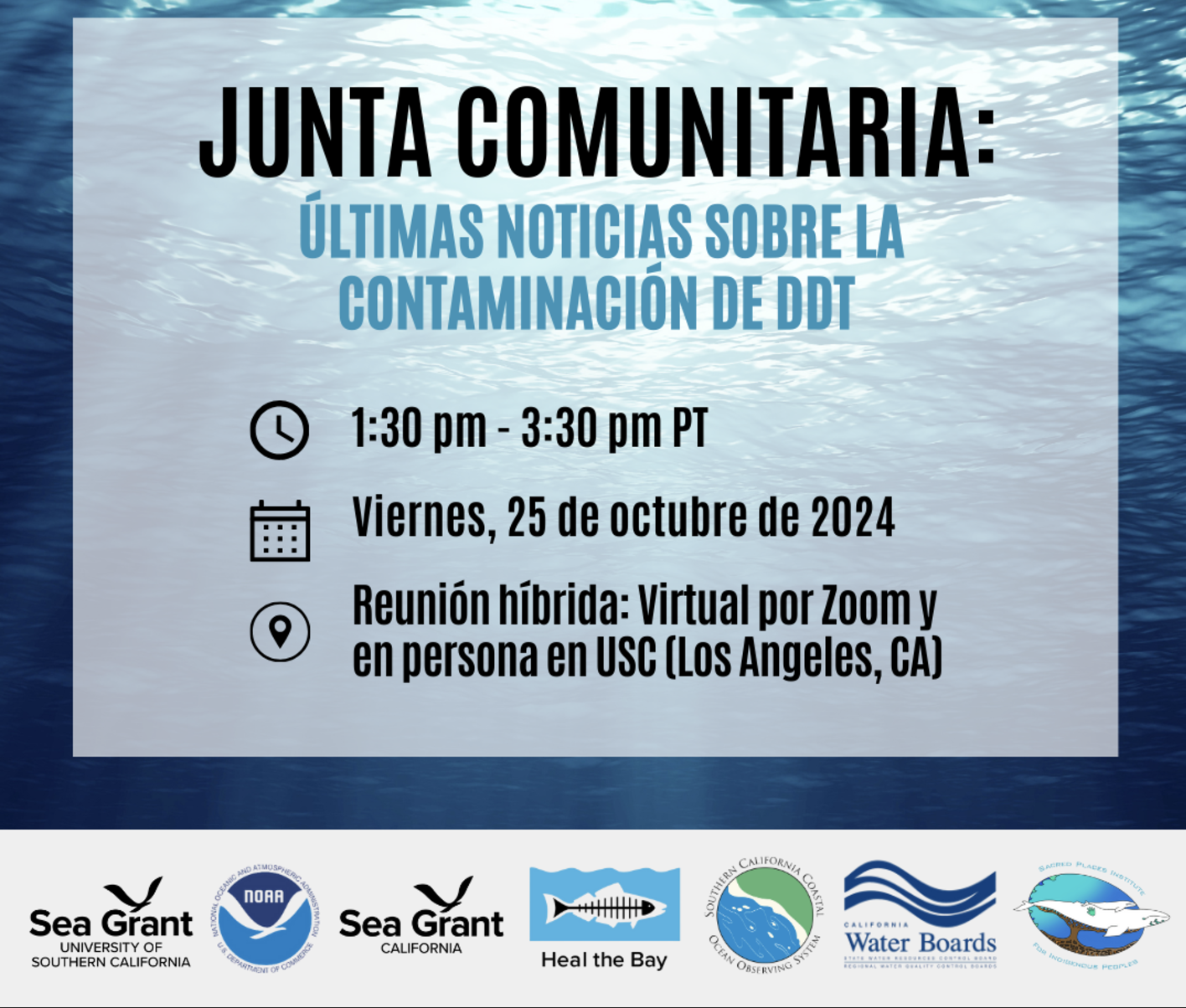Chemical Dumpsite Offshore Southern California
The deep ocean basins off the coast of Los Angeles have been historical dumpsites for various hazardous industrial wastes including the pesticide dichlorodiphenyltrichloroethane (DDT), petrochemicals, and other materials. This dumping is known to have occurred from the 1940s until 1972, when the Marine Protection, Research and Sanctuaries Act, also known as the Ocean Dumping Act, was enacted. Contemporary logs show that thousands of pounds of DDT and other chemicals could have been dumped in the basins.

THE LEGACY OF DDT+ IN SOUTHERN CALIFORNIA
- What was the historical use of DDT and how was it disposed of?
Commercial use of the insecticide DDT (dichlorodiphenyltrichloroethane) was banned in the United States in 1972, predominantly due to its high toxicity to wildlife and human health. The largest DDT producer in the United States, Montrose Chemical Corporation, historically disposed of DDT acid waste via wastewater outfalls to the Palos Verdes Shelf, as well as dumped into previously permitted deep-ocean dump sites in the San Pedro and Santa Monica Basins. The U.S. Environmental Protection Agency (EPA) designated the near-shore environment of the Palos Verdes Shelf as a Superfund site, meaning the previously contaminated site receives compensation for cleanup efforts and periodic monitoring to date. At this time, the EPA states that DDT contamination does not pose a significant health risk to those engaging in water contact recreation activities in the Palos Verdes Shelf, or consuming fish collected from this area.
- Why study DDT in the deep ocean now?
While the impacts of near-shore DDT on the Palos Verdes Shelf have been well-studied, very little is known about the status of DDT and other chemicals dumped in deep-ocean basin disposal sites and their impacts. The significant depth (up to 900 meters or about 2,953 feet) and lack of designated funds have made extensive exploration of deep-ocean disposal sites challenging, even though their existence has been documented since the 1980s. Montrose’s documents indicate that approximately 40,000 lbs per year of DDT and other chemicals could have been dumped in these basins from the 1930’s until 1972.
Recent media attention and advances in deep sea technology have sparked interest and urgency in further examining the dump sites. Important research interests include the following:
- There is now greater awareness of DDT breakdown compounds and related byproducts (>40 compounds in all), collectively referred to as “DDT+”, that have historically not been monitored and could have underestimated toxic effects.
- Sediments in the San Pedro Basin were found with DDT+ concentrations exceeding those at the Palos Verdes Superfund site, indicating a need for further risk assessment.
- Surveys revealed that “short-dumping” in transit to the disposal sites was commonplace, suggesting that the geographic scope of DDT+ contamination is likely to span beyond the designated deep ocean dump sites.
- Surveys identified numerous barrels on the seafloor with DDT+ contaminated sediment nearby, however, the highest sediment concentrations of DDT+ were not found near barrels, suggesting that DDT+ was largely bulk-dumped directly into the ocean rather than contained in barrels.
- DDT+ can enter the marine food web through ingestion of contaminated sediment. This raises questions about health risks to marine organisms at the top of the food chain, including humans who consume locally sourced seafood. Therefore, a greater understanding of how these higher and more spread out concentrations of DDT+ are impacting ecosystems and the food web is needed.
For more information on the detailed history of DDT and research to date in Southern California, please refer to the "A Deep Ocean DDT+ Research Needs Assessment of the Southern California Bight" report, Chartrand et al, 2022 and the EPA Region 9’s “Southern California Ocean Disposal Site #2 Investigation” website.

- Setting the stage for addressing California’s DDT challenge
- In early 2021, Scripps Institution of Oceanography conducted a preliminary survey that mapped the debris field (more than 36,000 acres of seafloor) between Santa Catalina Island and the Los Angeles coast, in the San Pedro Basin. In August 2021, scientists from Scripps Oceanography explored the DDT dumpsite, collecting sediment and biological samples around six barrels to understand potential ecological effects of the dump site and to determine the levels of DDT present in the ecosystem.
- In July 2022, the University of Southern California Sea Grant Program and the California Sea Grant Program engaged scientists, nonprofits, federal and state agencies, tribal representatives, and other Southern California Bight communities to assess what research is most urgently needed to address regional deep ocean DDT+ contamination. The resulting report, A Deep Ocean DDT+ Research Needs Assessment of the Southern California Bight, provides a comprehensive agenda for critical, deep ocean DDT+ research, thus informing future action to protect marine and human health. Scripps Institution of Oceanography researchers participated throughout the Assessment, and are conducting research that directly addresses the gaps outlined in the report.
- In September 2022, NOAA awarded $5.6 million in spending, directed by U.S. Senators Dianne Feinstein and Alex Padilla, to Scripps Institution of Oceanography. Working with collaborators from UC Santa Barbara and San Diego State University, this new research aims to fully characterize the extent of the dumpsite, identify the toxin “fingerprint” contained in the sediments, survey the effects of toxins on microbial communities and animals on the seafloor near the site, and assess toxin pathways to the upper ocean, including the potential for human exposure to toxins via fish and fisheries. The project will also explore potential remediation strategies, including the capacity for microbes to neutralize the toxins on the seafloor.
- In September 2023, NOAA awarded $6 million in spending, directed by U.S. Senators Dianne Feinstein and Alex Padilla, to Scripps Institution of Oceanography to fully assess contamination from DDT+ and other pollutants and bioremediation mitigation strategies. The additional research will validate an oceanographic DDT+ exposure risk model, conduct chemical sediment mapping of DDT+ wastes that were short dumped en route to Dumpsite 1, examine trophic transfer of DDT+ through biota in and around Dumpsite 1 and 2, assess the origin and fate of toxicants in the marine food web of the Southern California Bight, with a focus on species that may be vectors of contamination to human consumers, characterize the biological remediation potential of sediment microbes in the San Pedro Basin, and determine whether biodegradation can reduce DDT+ accumulation in wildlife destined for consumption. Additionally, the project integrates a comprehensive coordination, data management, and visualization framework, alongside an educational outreach component aimed at translating and presenting data in accessible formats to diverse audiences.
Scripps Institution of Oceanography conducts DDT Research to address key needs
Scripps Institution of Oceanography researchers, working with collaborators from UC Santa Barbara and San Diego State University, have been conducting research to assess the extent and scope of contaminant impacts and mitigation strategies for deep ocean dumping sites in Southern California.
Read below for further information on each project AND CLICK HERE TO EXPLORE THE SOUTHERN CALIFORNIA DDT+ RESEARCH PORTAL.

Surveying extent of dumping at Dumpsites 1 and 2
Carried out by Dr. Eric Terrill & Dr. Sophia Merrifield
The goal of this work is to characterize the debris field at the San Pedro dump site, map the extent of the dumping, and outline the bottom type and variability of the physical environment at the dump site. The researchers are applying modern robotic surveying techniques such as acoustic and optical imaging to survey the seafloor within and around Dumpsites 1 and 2.
Photo Credit: Eric Terrill & Sophia Merrifield
Surveying DDT+ beyond Dumpsites 1 and 2
Carried out by Dr. David Valentine
The goal of this work is to conduct chemical sediment mapping to determine the location and disposition of DDT+ wastes that were short dumped en route to Dumpsite 1, and the extent to which those wastes currently impinge on Catalina Island. Samples are being collected as sediment cores, divided into vertical sections, and then analyzed for DDT+ using standard U.S. Environmental Protection Agency (EPA) methods.
Photo Credit: David Valentine
Assessing whether DDT+ settles on the ocean floor or recirculates
Carried out by Dr. Uwe Send
The goal of this work is to quantify DDT+ exposure in the deep basin and on the continental slope resulting from sediment resuspension, and for the first time quantify release of dissolved DDT+ from the sediment. To achieve this, the team is deploying one mooring to continuously measure chemical properties, turbidity and currents near the seafloor, capture suspended sediment, and quantify accumulated DDT+. The data from these measurements will indicate DDT+ exposure risk as a function of time and demonstrate the frequency of natural sediment disturbance and flushing events.
Photo Credit: David Valentine
Validating a model assessing DDT+ transport and exposure
Carried out by Dr. Sarah Gille & Dr. Matthew Mazloff
The goal of this work is to validate a DDT+ exposure risk model against on-the-ground observations of the Southern California Bight to identify factors that could impact DDT+ exposure risks within the region. The team is developing ocean models to provide spatial information on the motion of bottom waters, extending beyond the reach of the mooring measurements and will explore variability over the planned 6-9 month mooring deployment period and beyond.
Photo Credit: Schmidt Ocean Institute
Identifying bottom-dwelling organisms at Dumpsites 1 and 2
Carried out by Dr. Gregory Rouse
The goal of this work is to archive representative benthic invertebrates from Dumpsites 1 and 2 into the Benthic Invertebrate Collection at Scripps. The animals will then be identified to the highest degree of accuracy and establish a specimen and DNA baseline to be used across the sites for this study and future studies. The team is sampling, sorting, and identifying the benthic invertebrates of San Pedro and Santa Monica Basins from barrels and core samples. Experts on various taxonomic groups are aiding the identifications and at least one species has been discovered to date.
Photo Credit: Gregory Rouse
Examining the role of bottom-dwelling marine organisms in spreading toxins
Carried out by Dr. Lisa Levin & Dr. Carlos Neira
The goal of this work is to characterize the benthic animals in the San Pedro Basin in relation to the distance from waste barrels and sediment concentrations containing DDX. This work aims to understand the effect of DDT+ contamination on the structure and function of the benthic biota, and to examine the potential roles of animals in contaminant redistribution and trophic transfer. To do this, the team is capturing the size, structure, density, distributions, diversity and taxonomic composition and life habits of the benthic biota.
Photo Credit: Gregory Rouse
Analyzing DDT+ accumulation in ocean ecosystem around Dumpsites 1 and 2
Carried out by Dr. Lihini Aluwihare, Dr. Anela Choy, & Dr. Eunha Hoh
The goal of this work is to create an inventory of DDT+ in both sinking and suspended particulate organic matter and biota. The team will examine the trophic transfer of DDT+ in and around the deep waters of Dumpsite 1 and 2. To assess trophic connections, the team is collecting samples of particles, zooplankton and micronekton from different depths, sorting the organisms by ecological traits (e.g., vertical distributions and migration, diet, size, feeding mode), and conducting targeted and non-targeted analyses on the samples.
Photo Credit: Anela Choy
Analyzing whether bacteria can reduce levels of DDT+ in the ocean
Carried out by Dr. Jack Gilbert and Dr. Paul Jensen
The goal of this work is to assess the remediation potential of microbes in the sediments of the San Pedro Basin. The team is trying to find microbes that can degrade DDT into less toxic chemical compounds, such as carbon dioxide, and in turn reduce DDT+ accumulation in wildlife destined for consumption. To achieve this, the team analyzes the resident microbial communities and employs metagenomics to identify DDT-degrading taxa. Using computational simulations the team defines microbial assemblages that can alter DDT breakdown products and determine whether the defined microbial assemblages can reduce the bioaccumulation of DDT+ in oyster tissue.
Photo Credit: Dr. Colleen Burge
Examining how DDT+ could end up in fish we eat
Carried out by Dr. Brice Semmens
The goal of this work is to assess the origin and fate of DDT+ in the marine food web of the Southern California Bight, with a focus on species that may be ecologically important indicators of deep-sea contamination and/or vectors of contamination to human consumers. The research team is sampling tissue and quantifying toxicant concentrations in fish species targeted by commercial, recreational, and subsistence fishers. Additionally, existing fish consumption data is being synthesized and analyzed to better assess the vulnerability of particular subgroups within California coastal communities.
Photo Credit: Johanna Gutleben
Project Resources
Learn More
EXPERTS AT SCRIPPS
UC San Diego’s Scripps Institution of Oceanography has a variety of scientific experts on this issue. These scientists can provide expertise on methods to identify the scope and condition of the dumpsite, the processes that transport and alter composition of the dumped chemicals, biological pathways that may lead to human exposure these impacts, and more.
Media Gallery
Visit the Seafloor Survey Media Gallery to find photos and graphics from recent surveys.

Headlines
THE HILL | Sep 9, 2025
Decades-old industrial dumping off SoCal coast still wreaking havoc on seafloor: Study
NEWSWEEK | Sep 9, 2025
Barrels dumped decades ago leaking caustic waste off Los Angeles coast
SAN DIEGO UNION-TRIBUNE | Sep 11, 2025
Scripps researchers discover what lies within mysterious haloed barrels on the seafloor
Contact Us
If you are a reporter interested in contacting a researcher to schedule an interview, or are interested in securing a speaker to discuss this issue at an upcoming event, please email scrippsnews@ucsd.edu.





